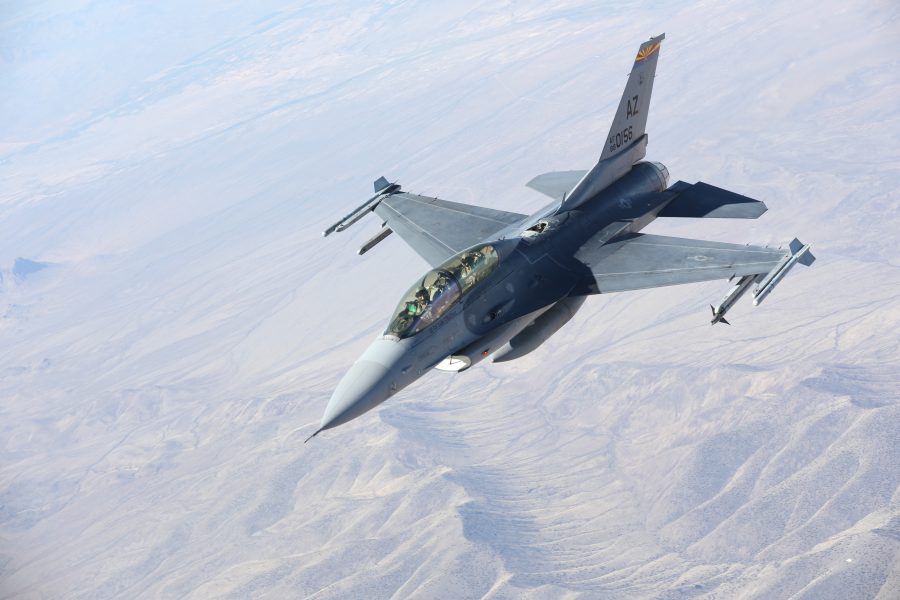As Ukraine awaits the delivery of F-16s in 2024, a U.S. defense official revealed new details on the training of Ukrainian pilots and maintainers in America.
There are currently four Ukrainian pilots undergoing F-16 training in the United States, the official told Air & Space Forces Magazine.
The instruction is occurring at Morris Air National Guard Base, Ariz., in Tucson, where they are training with the 162nd Wing, the U.S. Air Force’s dedicated foreign F-16 training unit.
Several other pilots are undergoing English-language training, the defense official added, while approximately 20 maintainers are also undergoing English-language training at Joint Base San Antonio, Texas, for the next several months.
The new details come after assistant secretary of defense for international security affairs Celeste Wallander said F-16 pilot training for Ukraine is “on track” after a virtual meeting of the Ukraine Defense Contact Group, a gathering of over 50 countries that coordinates military aid.
“We are aiming to provide an initial operating capability for Ukraine with its F-16 program in 2024, which would entail trained pilots, the platforms, but in addition, trained maintainers and sustainers, infrastructure, and spare parts, ammunition,” Wallander told reporters at the Pentagon on Jan. 23.
The F-16 efforts are coordinated by an Air Force Coalition within the Ukraine Defense Contact Group. The U.S. government must sign off on any F-16 transfers, a move the Biden administration initially resisted before promoting the effort. However, the U.S. does not plan to provide its own F-16s.
Pilots at Morris complete the six-month “B Course”—or Basic Course—designed to instruct foreign and American pilots familiar with other combat jets in the fundamentals necessary to transition to the F-16. That is the course the four Ukrainian pilots are now undergoing, the defense official said.
The 162nd Wing has been training foreign pilots for decades, with pilots from over two dozen countries traveling through Tucson to learn to operate one of the most successful multi-role fighters in history.
Ukrainian pilots began their training in Tucson in late October. In November, the Pentagon estimated training would take five to nine months, based on the skills of individual pilots.
Denmark is leading efforts in Europe to train Ukrainians on F-16s. In August, Denmark said it had begun training eight pilots and over 60 maintainers. An additional six pilots were sent to Denmark after spending time learning “aviation-specific” English and spending time in Royal Air Force training aircraft—the RAF does not operate F-16s—to learn the “NATO standard approach to flying,” the U.K. Ministry of Defense announced in late December. “Alongside the pilot training, dozens of Ukrainian aircraft technicians are also receiving English language training, geared towards engineering,” the U.K MOD added.
While Ukraine has many experienced pilots, they also must learn Western airpower doctrine to be most effective with the F-16. Ukraine has previously flown MiGs and Sukhois, not Western jets. F-16s are single-seat, single-engine airplanes with a complex hands-on throttle-and-stick (HOTAS) system, with toggle switches and buttons on the flight control that can conduct the full range of F-16 functions.
In Tucson, pilots spend extensive time in the simulator, even before getting airborne. Once aerial training begins, typically three-fourths is done with pilots on their own in the cockpit in single-seat F-16Cs, with time in dual-seat F-16Ds with an instructor in the back weighted towards the beginning of the course.
To achieve proficiency, a pilot must spend around 90 hours flying to learn and demonstrate all the necessary skills of the B-Course. However, training for Ukrainian F-16 pilots is not expected to precisely follow a rigid model, especially as training is occurring on multiple continents simultaneously.
But pilots are just one part of a complex weapons system.
“We are very slowly and very methodically going about this, and there is no great sense of urgency to get this moving forward,” retired Air Force Gen. Philip M. Breedlove, the former NATO Supreme Allied Commander, told Air & Space Forces Magazine. “Now, there’s good and bad to that. If we rushed these guys forward, we could rush them to fail.”
Breedlove said Ukraine and its allies need to start thinking about how the F-16s will be used with command and control and sensing platforms to better engage targets, where the F-16s will be based to prevent them from being destroyed, and where munitions will be stored.
“There’s so much that has to be done before the F-16s can be used effectively and effectively protected as an asset,” said Breedlove, a former F-16 pilot who commanded training and operational units. “An F-16 is a magnificent aircraft, and it will bring great capability to Ukraine. But an F-16 thrown into this conflict without any connective capabilities and without a good plan for protecting it as an asset on the ground is not a good recipe.”
Yurii Inhat, the spokesman for the Ukrainian Air Force, indicated a comprehensive approach to employing Ukraine’s F-16s was needed before the aircraft could be put in combat.
“Partners are ready to provide us with these capabilities. The question is whether everything is ready for their operation in Ukraine,” Inhat said on Ukrainian television recently. “It is clear that everything must be prepared, including pilots, infrastructure, and maintenance engineers, and also there are other factors that are not discussed as widely.”

